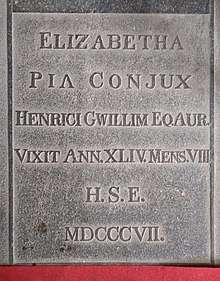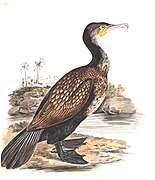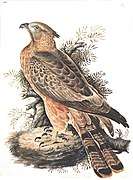Elizabeth Gwillim (bird artist)
Lady Elizabeth Symonds Gwillim (21 April 1763 – 21 December 1807) was an artist married to Sir Henry Gwillim, Puisne Judge[1] at the Madras high court until 1808. Lady Gwillim painted a series of about 200 watercolours of Indian birds. Produced about 20 years before John James Audubon, her work has been acclaimed for its accuracy and natural postures as they were drawn from observations of the birds in life. She also painted fishes and flowers.

Lady Elizabeth Gwillim | |
|---|---|
| Born | 1763 |
| Died | 21 December 1807, age 44 |
| Resting place | St. Mary's Church, Madras, India |
| Nationality | British |
| Known for | Watercolours of Indian birds |
| Spouse(s) | Sir Henry Gwillim |
Gwillim was born in the valley of Wye, Hereford, daughter of Hester and Thomas Symonds. Thomas Symonds Gwillim was an architect, monumental mason, and builder. A tower that he tried to improve in Hereford Cathedral collapsed leading to his dismissal but he was said to be an excellent statuary with many of his works around Herefordshire. Elizabeth married the Hereford lawyer Henry Gwillim on 27 May 1784 (Henry Gwillim was knighted in 1801). Along with her sister Mary Symonds, two clerks and two servants, the family moved to Madras. Apart from her bird paintings she is known for her letters (now in the British Library) which describe contemporary Indian culture including detailed descriptions of the devadasis and their role in society.[2] She died on 21 December 1807 of unknown causes and was buried at St. Mary's Church in Madras. Her husband resigned the next year and returned to England with the paintings.[3][4][5] She and her sister trained under George Samuel and her artistic work may have been influenced by the works of Thomas Bewick. It is unclear if she intended to publish her paintings. Many of the birds were brought to her by bird trappers and others. A specimen of the painted spurfowl, for instance, was brought to her by Rev. Vaughan on 24 August 1806, who captured them near Madras. They had two children Ann, baptised 10 June 1787, and Henry, baptised 11 October 1789.[6]
Lady Gwillim took an interest in botany and was in communication with other botanists in the region.[7] A species of Magnolia was placed in a new genus Gwillimia (Guillimia Rchb.) named by J.P. Rottler, presumably in her honour.[8][9]
About 121 paintings from were obtained from a private dealer by Casey A. Wood and these are held in the Blacker-Wood Library of McGill University.

 Oriental honey buzzard
Oriental honey buzzard



References
- Prinsep, Charles C. (1885). Record of services of the Honourable East India Company's Civil Servants in the Madras Presidency. London: Trubner and Co. p. 34.
- Spear, Jeffrey (2000). "Gods and Dancing Girls: A Letter from 1802 Madras". The Wordsworth Circle. 31 (3): 142–149. doi:10.1086/TWC24044119. JSTOR 24044119.
- Wood, Casey A. (1925). "Lady [Elizabeth] Gwillim—Artist and Ornithologist". Ibis. 67 (3): 594–599. doi:10.1111/j.1474-919X.1925.tb02943.x.
- Subramanya, S. (1994). "Paintings of Indian birds by Lady Elizabeth Gwillim at McGill University, Canada". Newsletter for Birdwatchers. 34 (4): 74–76.
- Wood, Casey A. (1927). "Lady [Elizabeth] Gwillim. Artist and ornithologist". Journal of the Bombay Natural History Society. 31 (2): 486–489.
- Walkinshaw, Allan. "Introduction". Elizabeth Gwillim. Artist and Naturalist 1763-1807. 27 May - 22 June 1980. Oshawa: The Robert McLaughlin Gallery. pp. 15–17.
- Wight, Robert; Walker-Arnott, G.A. (1834). Prodromus Florae Peninsulae Indiae Orientalis, containing abridged descriptions of the plants found in the peninsula of British India, arranged according to the natural system. Volume I. p. 46.
- Sims, John (1807). "Magnolia pumila". Curtis's Botanical Magazine. 25: 977.
- Wight, Robert (1840). Illustrations of Indian botany. Volume I. p. 11.